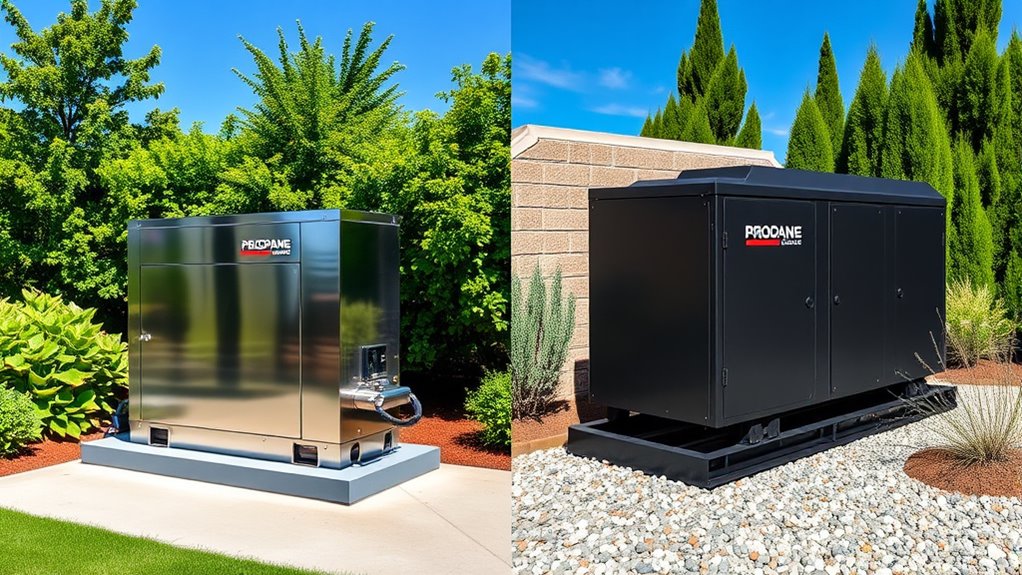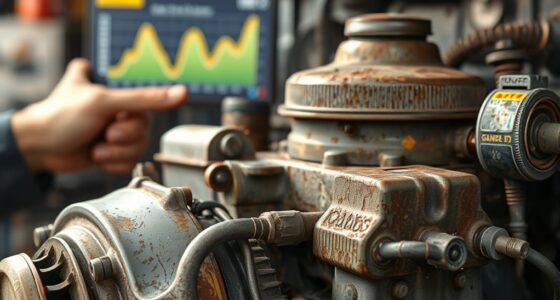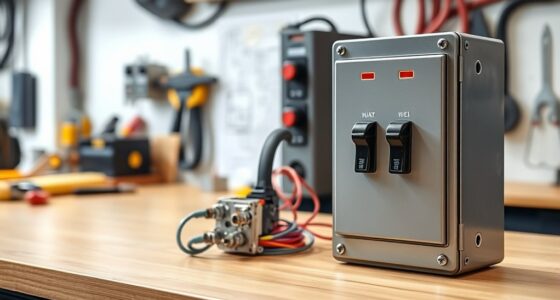When comparing natural gas and propane for standby power, remember that propane has higher energy content and burns cleaner, offering more heat quickly but requires storage tanks. Natural gas provides continuous supply through pipelines but depends on infrastructure. Cost, safety, and portability also play big roles; propane is flexible for off-grid use, while natural gas suits urban settings. Understanding these subtle differences guarantees you make smarter choices—if you keep exploring, you’ll discover the key rules most overlook.
Key Takeaways
- Propane offers higher energy density and faster heating, making it more efficient for standby power in remote or off-grid locations.
- Natural gas provides continuous supply via pipelines but can be disrupted by pipeline damage, unlike propane tanks that store fuel for long-term use.
- Propane systems require periodic refills and proper storage safety, whereas natural gas systems need less maintenance but depend on infrastructure.
- Upfront costs for natural gas generators are generally lower, but propane’s portability and storage flexibility may offset initial expenses over time.
- Environmental impacts differ: propane burns cleaner with fewer emissions, while natural gas leaks contribute significantly to methane-related climate effects.
Energy Content and Power Output Differences

Propane delivers considerably more usable energy per volume than natural gas, making it a denser fuel source. With about 2.4 to 2.5 times the energy per cubic foot, propane provides more heat in a smaller space, making it ideal for heating and power. A cubic meter of propane contains roughly 25 kWh, compared to just 10.3 kWh for natural gas. This higher energy density means propane appliances can generate more heat faster and often require less fuel to produce the same power. You’ll find that propane’s higher BTU content results in quicker heating and potentially smaller fuel needs. Because of this, propane can be more efficient in delivering power, especially where space or fuel efficiency matters most. This higher energy content also contributes to shorter heating times and improved performance in appliances designed for propane, which can be especially advantageous in energy-efficient setups.
Fuel Delivery and Storage Challenges
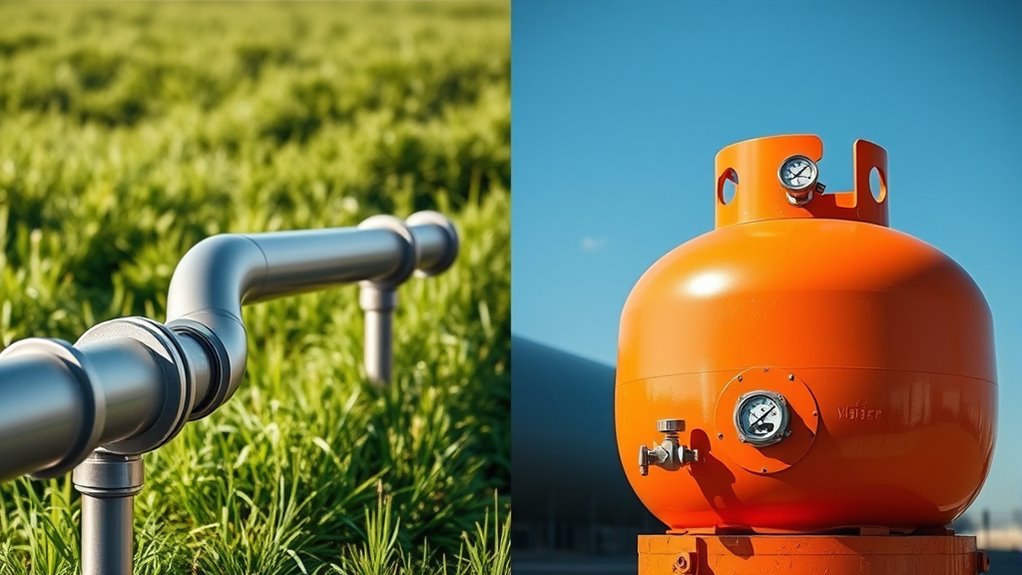
Delivering fuel efficiently can be challenging due to the differing infrastructure requirements of natural gas and propane. Natural gas flows continuously through underground pipelines connected to a gas grid, providing a seamless supply. Propane, however, needs periodic deliveries to refill on-site tanks, requiring careful scheduling. Consider these points:
- Propane delivery depends on tank access, which can be complicated by location, zoning, or property restrictions.
- Natural gas offers an uninterrupted supply, but pipeline damage can cut off many users simultaneously.
- Propane tanks need regular maintenance, leak detection, and proper siting to guarantee safety and compliance.
- Storage capacities vary, and proper management is essential to ensure supply during peak usage seasons.
- Efficient fuel delivery systems are vital to maintaining consistent energy availability and minimizing service disruptions.
While natural gas minimizes storage concerns, propane’s on-site reserves provide independence, but managing delivery logistics and storage safety adds complexity to your setup.
Cost Dynamics and Economic Considerations
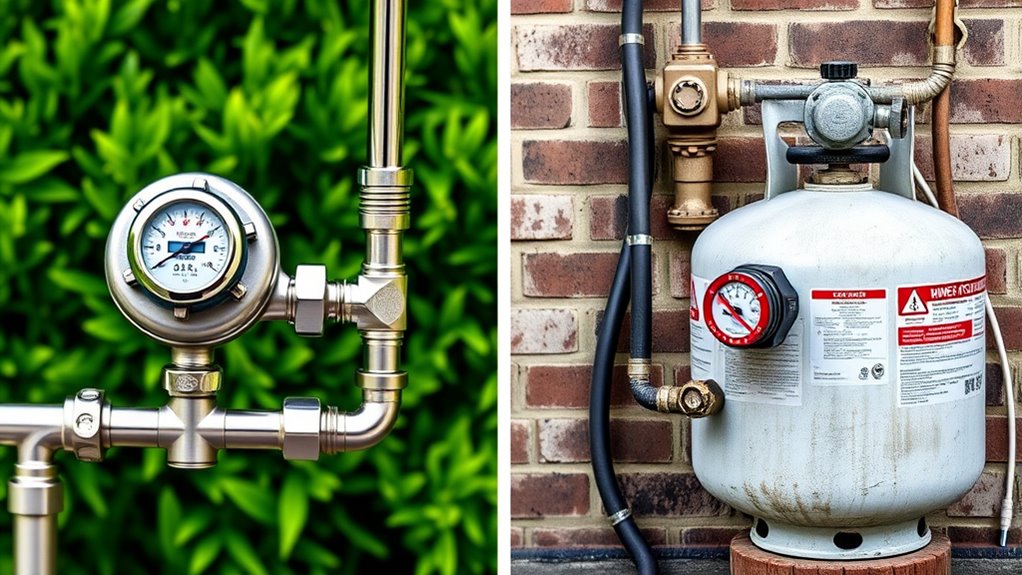
When choosing between natural gas and propane for your generator, understanding the cost implications is key. Natural gas typically costs around $90 per day, while propane runs about $220 daily. Although natural gas generators usually cost less upfront—around $9,000 versus $11,500 for propane—they often require existing infrastructure, which can add installation costs if absent. Natural gas is supplied through utility lines, which can be more reliable in the long run. Natural gas offers better energy efficiency per dollar since 1,000 cubic feet provide roughly 1 million BTUs at $15, while propane costs about $2.50 per gallon for similar energy output. Propane’s higher energy density means less fuel volume needed for the same power, but it requires on-site storage and refilling, adding logistical costs. Additionally, fuel storage considerations can impact overall operational costs and convenience. Long-term, natural gas’s steady supply and cleaner burn may offer more economical benefits despite higher initial installation costs.
Environmental Impact and Emissions Profiles
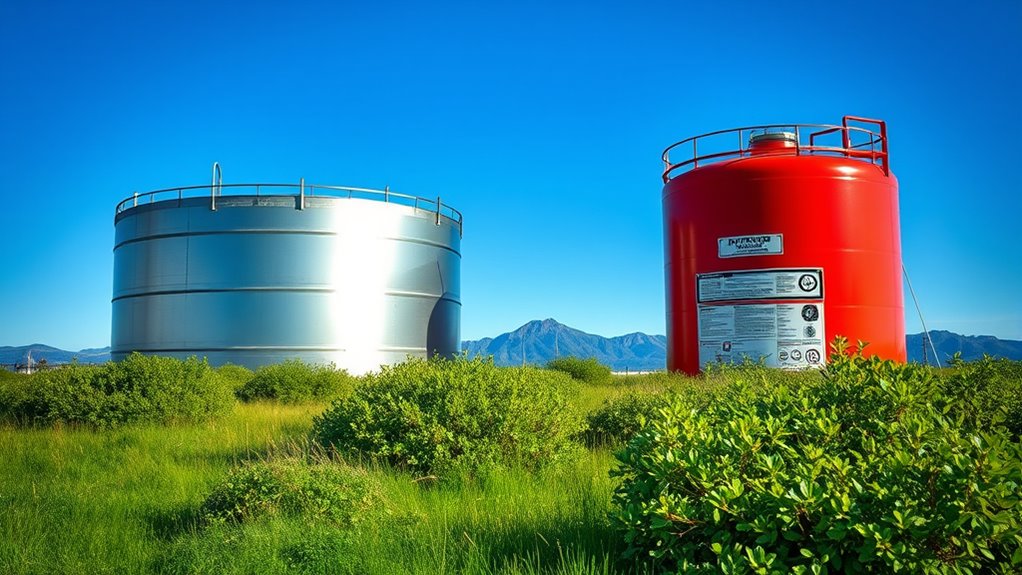
Understanding the environmental impacts of natural gas and propane requires examining their emissions profiles during combustion and leaks. Propane burns cleaner, producing fewer NOx, CO, SOx, PM, and VOCs. It emits virtually no ozone-depleting substances, reducing ground-level ozone formation. In contrast, natural gas releases less CO2 but emits methane—28 times more potent in warming than CO2. During leaks, methane considerably impacts climate change, despite quick dispersion. Propane’s lower upstream emissions result from fewer methane leaks during production and distribution, further reducing its environmental footprint. Consider these key points: 1. Propane’s lower upstream emissions result from fewer methane leaks during production and distribution. 2. Natural gas leaks contribute heavily to greenhouse gases, overshadowing its cleaner combustion. 3. Propane evaporates quickly and is non-toxic, minimizing soil and water contamination risks in leaks.
Installation Requirements and Safety Protocols
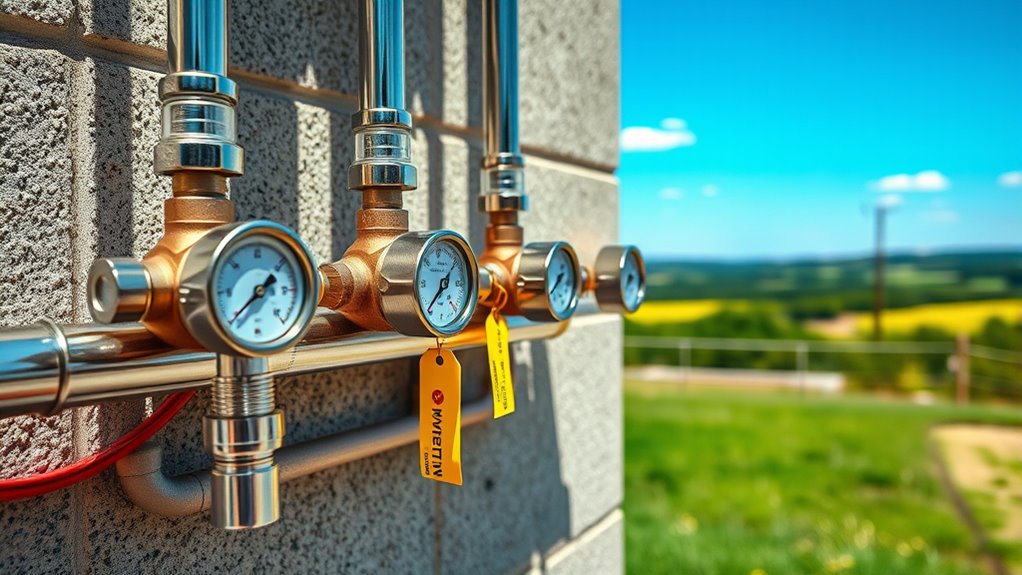
Installing a natural gas or propane generator requires strict adherence to safety protocols and code compliance to prevent accidents and guarantee reliable operation. You must hire licensed electrical contractors to install the automatic transfer switch (ATS) and verify wiring and generator sizing, ensuring everything meets local, state, and national codes. Licensed gas fitters connect the fuel supply lines, making sure connections are leak-free and compliant. Proper gas line sizing is essential; undersized lines can cause safety hazards or performance issues. Gas and electrical lines should be trenched separately and protected according to code. Generators need stable, level bases and proper clearances to prevent exhaust buildup and environmental hazards. Following these installation requirements and safety protocols guarantees safe, reliable operation of your generator system. Additionally, adherence to local building and safety regulations is crucial to avoid penalties and ensure insurance coverage. It’s also important to be aware of retail hours today for service providers involved in these installations to coordinate appointments efficiently.
Performance Variability and Load Efficiency

Propane generally provides more consistent performance and better load efficiency than natural gas because of its higher energy density. This means propane generators produce more power with less fuel, especially under varying loads. Here’s what you should know:
Propane offers more reliable power and efficiency due to its higher energy density than natural gas.
- Propane maintains higher output at partial loads, offering stable voltage and frequency during fluctuating demand.
- It consumes less fuel per unit of energy, resulting in longer run times and fewer refills.
- Propane units often deliver higher maximum power ratings due to its superior energy content, ensuring better performance under peak loads.
- NGMax™ Technology helps natural gas reach comparable power outputs, but propane’s inherent energy density still gives it an edge in overall efficiency.
- Additionally, propane’s storage stability allows for longer-term storage without degradation, making it a reliable fuel source for standby generators.
While natural gas burns cleaner, it requires higher flow rates, which can cause performance variability. Propane’s efficiency makes it a more reliable choice for consistent backup power.
Portability and Off-Grid Applications
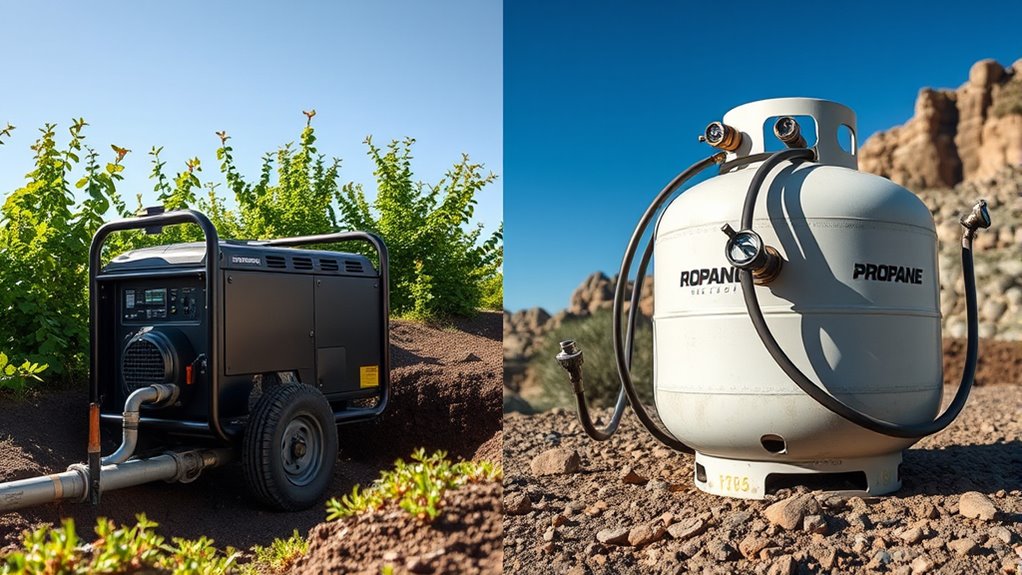
Propane’s portability and storage flexibility make it ideal for off-grid applications, allowing you to supply energy where infrastructure is unavailable. Its ability to be stored in portable tanks means you can set up reliable power in remote locations or during emergencies. Natural gas, however, depends on pipelines, limiting its usefulness off-grid and in mobile setups. Additionally, vetted newborn sunscreens are essential for protecting delicate skin in outdoor environments.
Off-Grid Power Flexibility
When it comes to off-grid power, portability plays a crucial role in guaranteeing you have reliable energy wherever you need it. Propane’s portable cylinders, like 20-pound tanks, are easy to transport and refill at retail locations, making them ideal for mobile and remote setups. Unlike natural gas, which requires a permanent pipeline connection, propane can be safely mounted on trailers or vehicles, offering true flexibility. Its higher energy density per volume means you can store more fuel in a smaller space, extending generator run times. This allows you to:
- Use portable fuel sources for recreational, emergency, or remote applications.
- Easily relocate equipment without infrastructure constraints.
- Operate reliably in diverse environments, regardless of location.
- Propane’s lower carbon footprint and environmental safety ensure that portable fuel use minimizes ecological impact during transportation and storage. Additionally, propane’s storage stability makes it a dependable choice for long-term off-grid use.
Propane’s portability ensures your off-grid power stays adaptable and dependable.
Fuel Storage Requirements
Proper fuel storage is essential for maintaining reliable off-grid power, especially when portability and long-term use are concerns. Propane’s indefinite shelf life means you can store it safely over extended periods if tanks are maintained properly—free of corrosion, sealed, and in ventilated, cool locations. This chemical stability ensures propane can be stored for decades without degradation, tank size affects storage duration: small cylinders last about 18-20 hours, while larger tanks can provide power for months. Portable propane tanks are easy to transport, making them ideal for remote or seasonal use. Underground tanks offer better protection against weather and temperature extremes, but require compliance with safety and installation regulations. Regular inspections of valves, connections, and gauges are critical to prevent leaks and guarantee safety during long-term storage.
Mobility and Remote Use
Propane offers unmatched portability for off-grid and remote applications, making it ideal for mobile use. Unlike natural gas, which depends on fixed pipelines, propane is stored as a compressed liquid in portable tanks or cylinders. This flexibility allows you to transport and use fuel virtually anywhere. Here are key advantages:
- Propane tanks vary in size, perfect for different mobile or temporary needs.
- It can be easily stored and transported, making it reliable during emergencies or extreme weather.
- Propane generators and appliances operate efficiently without pipeline access, ideal for remote sites, camping, or construction.
- Propane’s long shelf life ensures that stored fuel remains usable over extended periods without degradation. Additionally, the storage process for propane is straightforward and adaptable to various situations.
Natural gas’s reliance on infrastructure limits its mobility and off-grid use. Propane’s ease of transport and adaptable storage make it the better choice for remote or mobile applications requiring consistent power and heat.
Technological Innovations Narrowing the Gap

Technological innovations are closing the performance gap between natural gas and propane standby generators, making natural gas a more competitive option. NGMax™ technology allows natural gas generators to match propane’s power output by optimizing fuel delivery and combustion efficiency. This fuel-agnostic design ensures power ratings are comparable, despite propane’s higher energy density. Advances in natural gas infrastructure improve demand reliability, reducing fuel interruption concerns. Meanwhile, new propane tank designs enhance portability, safety, and ease of installation. Remote monitoring systems help manage fuel levels and maintenance, while improved fuel line technology minimizes leaks and maintains ideal pressure. Emission control technologies, like catalytic converters, lower pollutants and noise, making both fuels cleaner and more eco-friendly. These innovations collectively boost natural gas’s appeal, narrowing the performance and convenience gap with propane. Fuel delivery systems also continue to improve, ensuring consistent performance under varying conditions.
Maintenance and Long-Term Upkeep
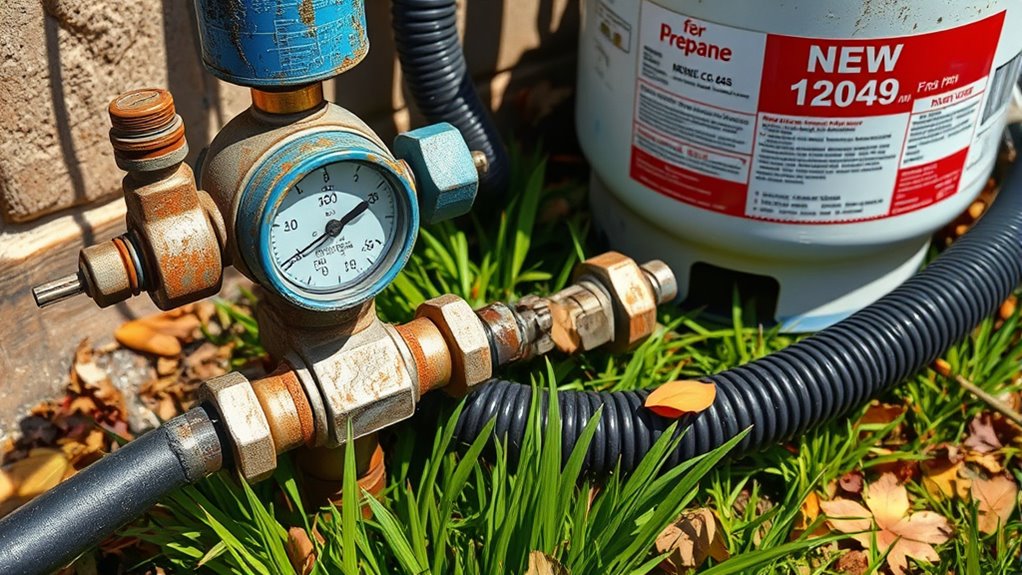
Maintenance and long-term upkeep are essential to keep your standby system operating safely and efficiently over time. Proper care prevents costly repairs and ensures reliable performance. To stay on top of system health, focus on these key areas:
- Regular inspections for leaks, rust, and damage in propane tanks and pipelines.
- Scheduled cleaning, certification, and professional maintenance for propane tanks and natural gas systems.
- Routine testing and replacement of valves, regulators, and connectors to maintain safety and efficiency.
- Natural gas systems benefit from pipeline monitoring and professional check-ups, while propane tanks require manual oversight of refills and exterior condition. Consistent upkeep reduces hazards, extends equipment lifespan, and keeps your system running smoothly. Additionally, paying attention to system diagnostics can help identify potential issues early and prevent unexpected failures.
Suitability for Different Home and Business Needs

Your home’s size, location, and energy demands determine whether natural gas or propane suits your needs best. Larger homes with access to pipelines often benefit from natural gas’s lower costs, while off-grid properties rely on propane’s flexibility. Understanding your power requirements helps you choose the most efficient and reliable fuel option. Natural gas’s infrastructure typically makes it more suitable for urban areas with existing pipelines, whereas propane offers independence from utility grids in rural or remote locations. Additionally, installation costs and ongoing maintenance should be considered when selecting between the two options.
Home Size Compatibility
Choosing between natural gas and propane for your home depends heavily on its size and location. Propane’s higher energy density makes it ideal for smaller or modular homes, where space for storage is limited. It burns more efficiently, providing more heat with less fuel, which benefits homes with high heating demands. Consider these points:
- Larger homes with multiple appliances often require bigger or multiple propane tanks.
- Smaller or remote homes benefit from propane’s portability and smaller storage needs.
- Urban areas with existing pipeline infrastructure favor natural gas, while rural or off-grid homes are better suited for propane.
- Additionally, understanding angel numbers can help homeowners gain insights into their energy choices and future decisions.
Propane’s flexibility in tank size and placement enhances its suitability across diverse home sizes. Your choice depends on your home’s size, location, and heating needs.
Off-Grid Applications
In off-grid settings, the availability and infrastructure for natural gas are often limited or nonexistent, making propane a more practical choice. Propane can be delivered via mobile tankers and stored on-site, giving you independence from pipelines and grid interruptions. Natural gas, on the other hand, requires costly underground infrastructure that’s rarely feasible in remote areas. Propane’s portability allows flexible placement of appliances and generators without rigid piping. It also has a higher energy density than natural gas, providing more power per volume, which means less storage space—ideal for space-constrained locations. Additionally, propane burns cleaner, producing fewer emissions and less maintenance. Its stability and safety for long-term storage make it well-suited for off-grid homes and businesses seeking reliable, environmentally friendly energy without dependence on extensive infrastructure. The use of sound science in understanding combustion and storage safety can further enhance the benefits of propane in these settings.
Power Demand Flexibility
Propane offers significant power demand flexibility thanks to its higher energy density and efficient fuel use, making it well-suited for homes and businesses with variable or high peak energy needs. Its ability to generate more heat or power with less fuel allows you to respond quickly to changing demands. For example:
- You can scale up or down by adding or removing tanks, adapting to fluctuating loads.
- Propane’s on-site storage ensures reliable fuel supply regardless of external factors.
- Its higher efficiency means less fuel is needed during peak periods, reducing costs and downtime.
- Additionally, propane’s storage capacity allows for greater supply security during supply chain disruptions.
This flexibility makes propane ideal for locations with unpredictable or high energy spikes, giving you greater control over your fuel management and power delivery, especially where infrastructure limits natural gas options.
Frequently Asked Questions
How Does Fuel Availability Affect Generator Operation During Extended Outages?
Fuel availability directly impacts your generator’s operation during extended outages. If fuel runs out or becomes contaminated, your generator may fail or perform poorly, risking critical system downtime. Regular testing, proper storage, and timely resupply are essential to keep fuel in good condition and ensure continuous power. Planning ahead with emergency fuel strategies and inventory management helps prevent shortages and keeps your generator reliable when you need it most.
What Are the Safety Considerations for Storing Propane Tanks at Home?
When storing propane tanks at home, you should place them outdoors in well-ventilated, shaded areas on stable surfaces. Keep tanks upright, away from buildings, ignition sources, and excessive heat. Guarantee proper distances—at least 10 feet for larger tanks—and never store them inside or in enclosed spaces. Always turn off valves when not in use, secure tanks during transport, and inspect regularly for damage to prevent leaks or accidents.
How Do Local Regulations Impact Natural Gas Versus Propane Installations?
Think of local regulations as the rulebook for your energy landscape; they shape where and how you can install natural gas and propane systems. You’ll find natural gas installations constrained by pipeline access, while propane offers more flexibility with on-site tanks. Zoning laws set boundaries—distances from structures or property lines—ensuring safety. Complying with these rules is like steering a course, guiding you safely through your energy setup journey.
Can Generators Switch Between Natural Gas and Propane Easily?
Yes, you can switch your generator between natural gas and propane, but it requires some steps. You’ll need the appropriate conversion kit, which includes regulators and hoses, and follow the proper procedure: run on gasoline first, then switch to propane or natural gas. Adjust the fuel mixture screws, shut off valves correctly, and make certain all seals are tight. The process takes a few hours and involves careful setup for safe operation.
What Is the Typical Lifespan of Propane Versus Natural Gas Generator Components?
Think of your generator as a durable marathon runner, with lifespans that depend on how well you care for it. Propane generators typically last 20-40 years, often outlasting natural gas models, which usually run about 25-30 years. Proper maintenance and clean fuel keep both running smoothly longer. Fuel quality, operating hours, and brand reputation are essential. With good care, you can expect decades of reliable service from either fuel type.
Conclusion
Understanding the differences between natural gas and propane isn’t just about specs—it’s about how each fuel fits your needs. Coincidentally, what’s best for your home or business often depends on your location, storage options, and budget. As technology advances, the gap narrows, making choice easier. Ultimately, staying informed guarantees you select the right standby fuel, because in the end, your energy decision shapes your comfort and efficiency—sometimes, it’s all about timing.

